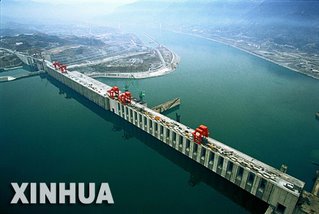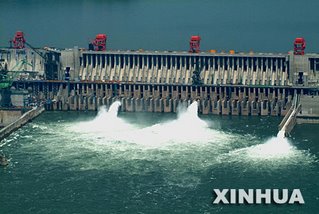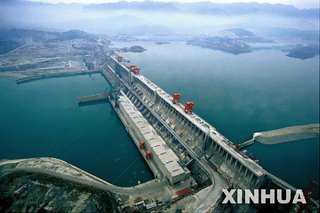



• It is the world's largest in terms of electricity production and overall investment; it is not the biggest dam in the world. Grand Coulee Dam in the U.S. which is slightly larger in terms of size.
• The impact the dam will have on China's future development in terms of flood control, increased trade on the upper reaches of the Yangzi, and of course reduced energy prices.
• Sun Yat Sen, the founder of the Chinese Republic, supported the idea of this dam when it was first mooted in 1919.
Three Gorges Dam Vital Statistics
• Dimensions: 185 m (606 ft) high and 1,983 m (6,500 ft) broad
• Water Level Increase: Water level is planned to rise in 2 stages; by 2004 it will increase by 30 m to 125m (426 ft) and by 2009 will increase another 50m to 175 m (575 ft)
• Cost Estimate: 1985 Chinese estimate of US$10 Billion is acknowledged to be too low. Estimates abound from 2 to 5 times that amount
• Financing: Mostly from a national energy tax; other portions have been raised from government bonds
• Materials Used: 10.8 million tons of cement, 1.9 million tons of rolled steel and 1.6 million tons of timber
• Construction Period: 1993 - 2009
• Land submerged: 13 cities, 140 towns, 1352 villages, 657 factories & 30,000 hectares of cultivated land
• Relocation of People: 1.3 million to be relocated in 3 stages in 1997, 2003 & 2009
• Energy Production: 84 Billion kilowatt hours per year; enough to supply 11-15% of China's energy.
Three main benefits:
• Flood Control - the primary reason for this project is to contain flooding in the upper reaches of the Yangzi. Critics counter that this is only to the maximum height of the dam - 185 meters. After the 22.5 billion cubic meter flood control capacity is exceeded, there is nothing to prevent the overspill from invading the exposed lower valleys. According to this argument, were the freak floods of 1954 and 1870 to recur the dam could do little to contain them. Further, these critics argue, in terms of flood control this dam does nothing about the problem of flooding in the middle and lower reaches of the river. A corollary to the flood control benefit of the three gorges dam project is the plan to construct a 600 kilometer canal from the three gorges reservoir to Beijing. From 2007, this will be able to divert up to 80 billion cubic meters of soft water per year to the water-starved north
• Energy Production - China's phenomenal economic growth has killed the debate surrounding this issue. It now appears that the Chinese leadership was correct to assume the utility of the dam's electricity production. Whereas naysayers had argued that China's coal production would keep pace with her industrial development, this is certainly no longer the case. Already, in 2005, China is importing one third of its energy needs.
• Navigation - the huge reservoir created by the dam will make the upper Yangzi navigable to 10,000 ton barges. To date the water levels of The Three Gorges have limited passage to 3,500 ton barges. Given the growth of Chongqing, China's most populous municipality, proponents of the project claim that the Three Gorges Dam will reduce freight costs and facilitate trade in this area. Some scientists however, fear that the soil erosion caused by excessive tree felling in the Yangzi's upper waters will result in large deposits of silt at the dam and along its backwaters to Chongqing port. This, they counter, will hamper navigation.
• In considering the pros and cons of this ambitious, national project, it would be short-sighted not to acknowledge China's expertise in the field. Between 1949 and 1980 China constructed 80,000 reservoirs and hydroelectric plants. One of these, the Gezhouba Dam, the first dam to be built on the Yangzi, was partly intended as a direct precursor to the Three Gorges Dam. As a result, the same construction company that built the Gezhouba dam, is also responsible for the completion of the Three Gorges Dam. Similarly, the excellent relations established between the Chinese government and Western companies like ABB, GE Canada, GEC Alstholm and Suzler Escher Wyss on the Geheyan Dam project will be put to good effect for the gigantic and spectacular Three Gorges Dam
